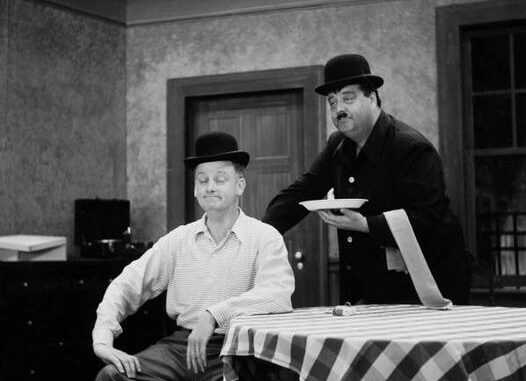
1956 The cast of the Honeymooners relaxes between shows

“And awaaaaaay we go!”
Chances are, if you’ve turned on a television in the past five decades, you’ve probably caught at least one episode of The Honeymooners. A scheming bus driver, a doofus sewer worker, and two long-suffering wives… these were the ingredients for one of the most widely-watched sitcoms in television history. If the 1950’s were television’s golden age, then The Honeymooners was pure platinum.
The characters of Ralph & Alice Kramden and Ed & Trixie Norton originally grew out of stage and screen comedian Jackie Gleason’s sketch work in television’s early days. The DuMont network’s Cavalcade of Stars featured the earliest Honeymooners appearances, with Gleason taking on the persona of large-girthed, loud-mouthed, but generally good-hearted bus driver Ralph Kramden. Joining Gleason were Art Carney as the dimly cheerful city sewer worker Ed Norton and Pert Kelton as Ralph’s wife Alice.
In 1952, Gleason moved to his own CBS show, The Jackie Gleason Show, and The Honeymooners came with him. Carney stayed on as Norton, Audrey Meadows took over Alice’s role, and Joyce Randolph was brought in as Ed’s loving wife Trixie. It was this foursome that would become the darlings of American television for years to come. The idea may have been as simple as any sitcom on television—Ralph and Alice had been married for fifteen years, lived in a small apartment in New York City’s Brooklyn borough, and best friends Ed and Trixie lived upstairs—but the comic quartet made every episode a fresh experience.
Plots usually revolved around everyday experiences taken to the extreme: If Ralph wanted to win a “guess the number of jellybeans” store contest, he wouldn’t just make an educated guess; he’d spend Alice’s shopping money to try to recreate the store’s jar exactly. Naturally, Ralph’s plans were almost always doomed to failure, but fifteen years of marriage had taught Ralph and Alice a thing or two about finding a happy ending no matter how big the screw-up.

It was impossible not to love The Honeymooners. They were just average Joes and Janes trying to get by—Ralph and Ed loved bowling, hated mothers-in-law, and their only political aspirations were a good position in the Raccoon Lodge. But above all, they were fun to watch. And watch we did, making The Honeymooners the most popular part of The Jackie Gleason Show.
CBS expanded The Honeymooners into its own half-hour series in 1955, but by the following season, it was once more part of The Jackie Gleason Show. When Art Carney left his regular gig on the show in 1957, The Honeymooners became a very rare treat on Jackie Gleason’s various series. But in 1966, the popular characters were reunited on a new Jackie Gleason Show.
Sheila MacRae and Jane Kean became the new Alice and Trixie, respectively, and the new episodes often featured big musical numbers featuring the multi-talented cast. Partly due to Jackie Gleason’s relocation to Miami Beach, Florida, the show’s plots also expanded beyond the confines of the Kramden’s Chauncey Street apartment. The two couples even took a European vacation for a string of episodes, but no matter where they went, Ralph’s big ideas and Ed’s earnest gullibility were sure to cause problems.
The Honeymooners stopped production at the start of the 1970’s, but the show’s legacy was far from over. Almost immediately, episodes of the show went into heavy syndicated rotation, and TV audiences everywhere were given a non-stop diet of Kramden and Norton comedy. The mid-1950’s cast reunited for a string of specials in the mid-70’s, and in 1984, cable’s Showtime network debuted The Honeymooners: The Lost Episodes—actually rare kinescope recordings of Honeymooner sketches that had never been released into syndication.
Episodes of The Honeymooners still air on televisions everywhere, and the show’s pull is still strong in pop culture. Even if you don’t realize it, you’ve probably quoted Ralph or Ed sometime in your life: “To the moon, Alice,” “One of these days, Alice, one of these days…Pow! Right in the kisser!,” or maybe the one quote that sums up this evergreen show better than any other:
